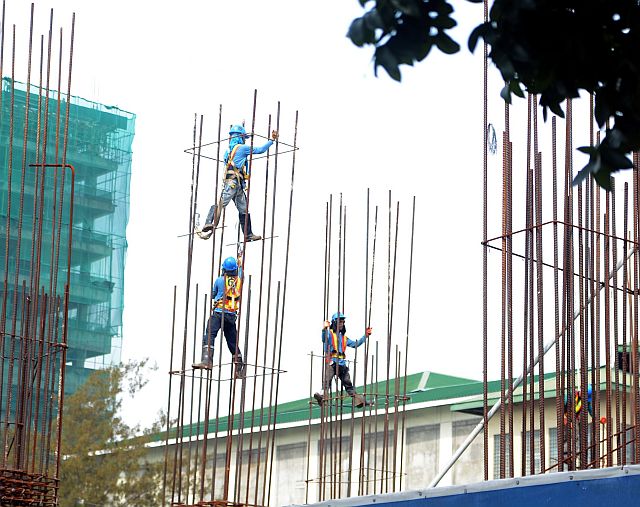
Construction workers work on a building in Cebu City in this 2015 photo. According to Director Rolando Taghap of the Philippine Statistics Authority in Central Visayas (PSA-7) in a press briefing, a subsector of the construction industry contributed to the slowdown in growth of the region in 2015. With him were Romeo Recide, PSA-7 deputy national statistician and National Economic Development Authority Central Visayas Director Efren Carreon. CDN FILE and LITO TECSON
Increased spending on infrastructure, which is the thrust of the Duterte administration especially on improved transport facilities, is expected to grow the Philippine logistics industry by at least 300 percent in the next four years.
Jonathan Cabaltera, assistant chief of the supply chain and logistics management division, an advisory body under the Department of Trade and Industry (DTI), said the industry is projected to expand from an actual value of P100 billion in 2013 to P326 billion in four years, given the right infrastructure, policies, regulations, and institutional support.
“We are very much optimistic (that we will hit our projection) because there are a lot of infrastructure developments going on right now,” he told reporters at the sidelines of the Supply Chain and Logistics Roadshow in Cebu City on Thursday.
The administration of President Rodrigo Duterte earlier announced plans to ramp up infrastructure spending up to 7 percent of the country’s Gross Domestic Product (GDP) starting 2017, and projects to spend a total of P7 trillion until 2022.
Challenges
Cabaltera said the country’s logistics industry faces four challenges including policies, regulation, institution, and infrastructure.
“Of the four, infrastructure remains to be the main challenge,” he said, adding that the government has been underspending even while the Philippine economy has been enjoying gains quarter after quarter.
The country’s GDP grew 7.1 percent in the third quarter this year, but infrastructure needs a lot of catching up to do, said Cabaltera.
“There is a lot of congestion on roads and in seaports and airports because we haven’t been building enough,” he added.
Congestion contributes to an increase in prices such that in the Philippines, logistical costs account for 24 to 53 percent of wholesale prices, shipping and port handling costs account for 8 to 30 percent, depending on the goods and routes, and 5 percent of the retail price of goods.
Logistics performance
The Philippines ranked 57th out of 160 countries in the World Bank’s Logistics Performance Index, which measured the weighted average across six dimensions such as customs, infrastructure, international shipment, logistics quality, tracking, and timeliness, obtained through a structured online survey of logistics professionals.
The construction of more roads, expansion and improvement of existing airports and seaports all over the country, as well as the creation of several laws are among the recommendations included in the proposed National Logistics Master Plan (NLMP) 2016-2022.
Cabaltera said the plan aims to advance the competitiveness of the Philippines through a more efficient logistics sector that contributes to a robust and resilient economy.
Projects in Cebu expected to address the problem of congestion include the construction of a second terminal at the Mactan-Cebu International Airport (MCIA) and the new International Container Port in Consolacion, northern Cebu.
Recommendations
Other recommendations in the draft NLMP include the amendment of the Public Service Act, easing restrictions on foreign ownership of enterprises in the country, transportation included, as well as the passage of the Public-Private Partnership (PPP) law and the pursuit of PPP projects.
The DTI is set to release the final version of the NLMP by February 2017, said Cabaltera.
“What we are doing now is trying to get more information that could help us craft the plan. We are having this roadshow to get buy-ins and support of the stakeholders in Cebu,” he said.
Next stops
Cebu is the second venue of the roadshow after Iloilo earlier this week. Zamboanga, Batangas, and Legaspi are next on the DTI’s list.
More than the movement of goods and services from one point to another, logistics is defined as a part of the supply chain that covers information flow, material handling, production, inventory, transportation, warehousing, border regulatory procedures, and security.